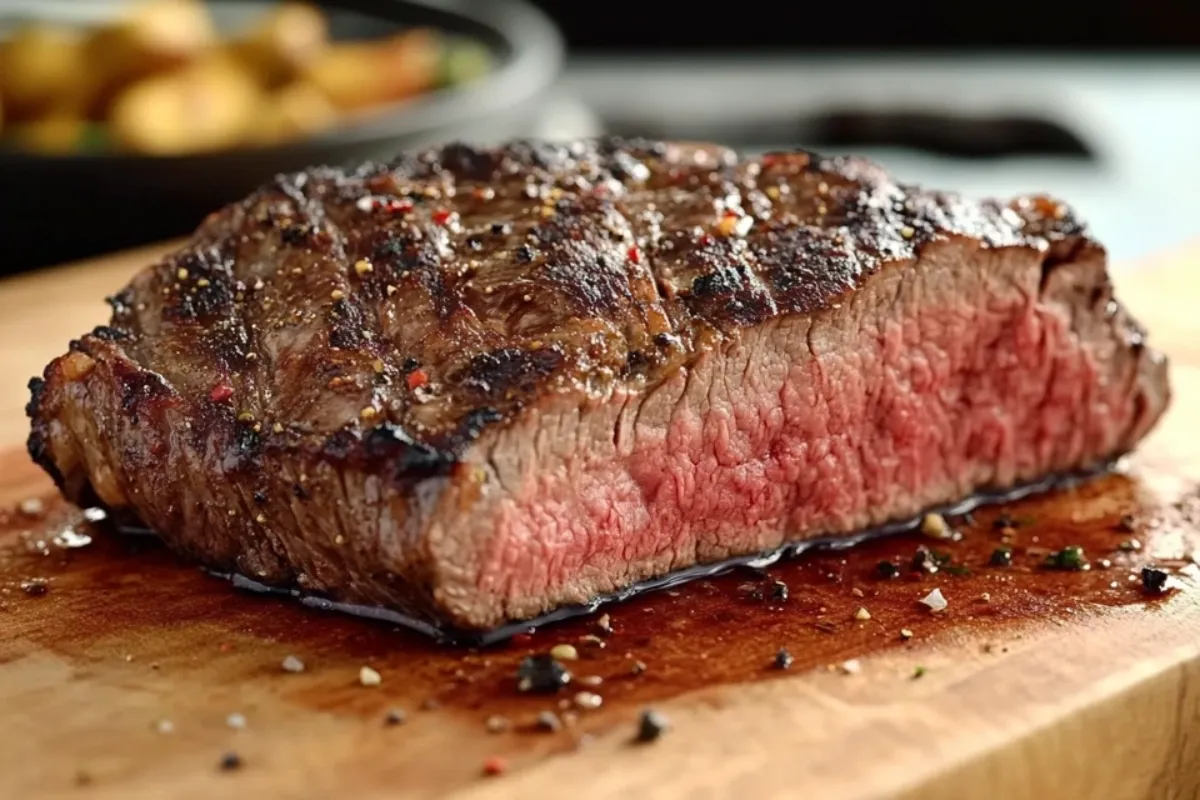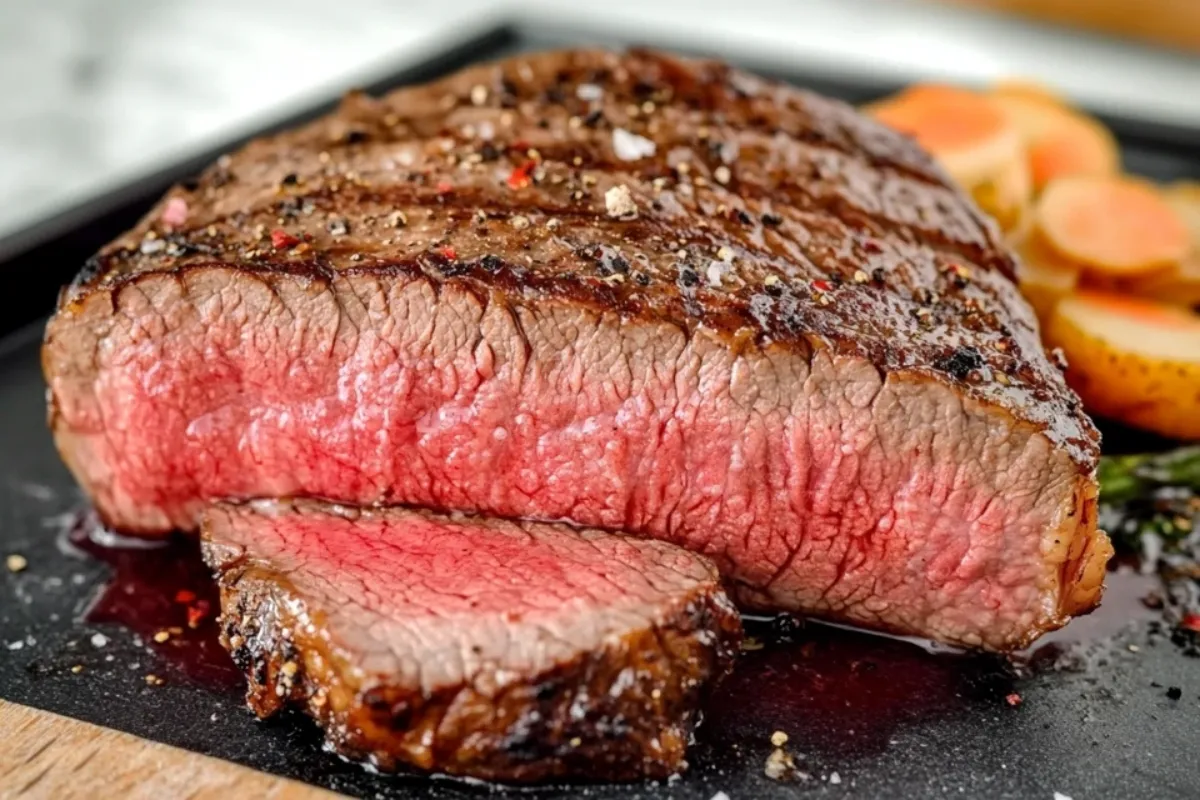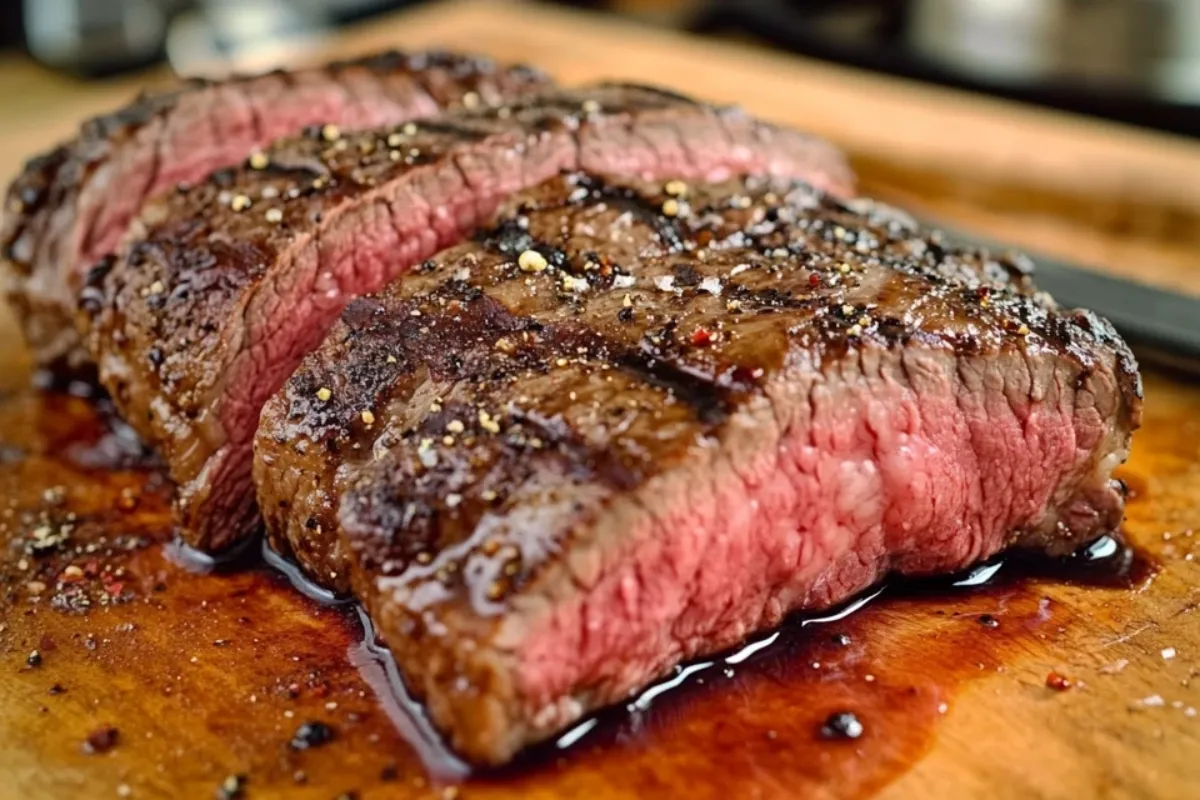Table of Contents
ToggleIntroduction
Beef striploin is a tasty and flexible cut of meat. It is loved for being tender and having a good amount of marbling, which adds flavor. Often used for steaks and roasts, this cut is a favorite for both chefs and home cooks. Because it balances flavor and texture so well, beef striploin is popular in restaurants and kitchens all over the world.
What is Beef Striploin?
Understanding the Cut
Beef striploin comes from the short loin of the cow, near the tenderloin. This boneless piece of meat is known for its marbling, which makes it juicy and flavorful when cooked.
Other Names for Beef Striploin
Depending on where you are, beef striploin may be called:
- New York Strip
- Kansas City Strip
- Club Steak
Common Uses for Beef Striploin
You can use beef striploin in many ways, such as:
- Grilling or pan-searing for steaks.
- Roasting for special meals.
- Slicing thinly for stir-fries.
Why is Beef Striploin Good for You?
Nutritional Breakdown
Beef striploin is high in protein, has moderate fat, and is naturally low in carbs. This makes it a good choice for many diets.
Important Nutrients
- Iron: Helps your body stay energized and move oxygen.
- Zinc: Boosts your immune system.
- Vitamin B12: Keeps nerves healthy and helps make red blood cells.
How to Choose the Best Beef Striploin
Things to Look For
- Marbling: Streaks of fat add flavor and make the meat juicier.
- Color: Pick meat that is bright red; it’s fresher.
Bone-In or Boneless?
- Bone-In: Adds more flavor.
- Boneless: Easier to cook evenly and slice.
Ways to Cook Beef Striploin
Grilling Steaks
- Choose steaks that are 1 to 1.5 inches thick so they cook evenly.
- Preheat your grill to high heat for a good sear.
Pan-Searing for More Flavor
- Use a hot pan to make a golden crust.
- Add butter, garlic, and rosemary for extra flavor.
Roasting for Special Occasions
- Rub the meat with olive oil and herbs.
- Roast at 375°F (190°C) until it’s cooked to your liking.
Easy Recipes for Beef Striploin
Classic New York Strip Steak
Ingredients:
- Beef striploin steak
- Salt and pepper
- Butter, garlic, and thyme
Steps:
- Season the steak with salt and pepper.
- Sear it in a hot pan for 3–4 minutes on each side.
- Add butter, garlic, and thyme, and baste the steak as it cooks.
Herb-Crusted Beef Striploin Roast
Ingredients:
- Whole beef striploin
- Olive oil
- Fresh rosemary, thyme, and minced garlic
Steps:
- Rub the meat with olive oil and herbs.
- Roast in the oven until it’s done the way you like it.
- Let it rest for 10 minutes before slicing.
How to Store and Reheat Beef Striploin
Storing in the Fridge
- Keep cooked meat in airtight containers.
- Eat it within 3–4 days.
Freezing for Later
- Wrap the beef tightly in plastic wrap and foil.
- Freeze for up to six months.
Reheating Tips
- For steaks, reheat in a pan with a little broth.
- For roasts, use an oven set to 300°F (150°C).
Comparing Beef Striploin to Other Cuts
- Ribeye: Has more fat and is richer in flavor.
- Tenderloin: Softer but less flavorful.
- Sirloin: Cheaper but not as tender.
Why Beef Striploin is Popular
A Restaurant Favorite
Beef striploin is a top pick in steakhouses because of its great flavor and texture. Dishes like the New York Strip show how versatile it is.
Loved Worldwide
- France: Served with fries in “steak frites.”
- Japan: Used for premium grilling like yakiniku.
Perfect Sides and Drinks for Beef Striploin
Great Side Dishes
- Mashed potatoes
- Grilled asparagus
- Garlic butter mushrooms
Best Wine Pairings
- Bold red wines like Cabernet Sauvignon go well with the richness of beef.
- For a lighter choice, try sparkling wine.
Cooking Tips for the Best Beef Striploin
- Let the meat rest for 5–10 minutes before cutting it to keep it juicy.
- Always slice against the grain for tenderness.
- Don’t overcook it; use a meat thermometer to check the temperature.
Smoking Beef Striploin
Smoking adds depth and complexity to striploin roasts:
- Use woods like hickory or oak for a bold, smoky flavor.
- Slow-cook at a low temperature for tender and flavorful meat.
Dry-Aging Striploin
Dry-aging intensifies flavor and improves tenderness:
- Purchase a dry-aged striploin or dry-age at home with controlled temperature and humidity.
- Slice thinly to savor the concentrated flavors.
Tips for Buying High-Quality Beef Striploin
Choosing the Right Butcher
- Find a reputable butcher who sources beef from trusted farms.
- Ask about the animal’s diet, as grass-fed beef often has a more complex flavor.
Understanding Grades of Beef
- Prime Grade: High marbling for exceptional flavor and tenderness.
- Choice Grade: Less marbling but still tender and flavorful.
- Select Grade: Leaner with less marbling, ideal for health-conscious eaters.
Local and Sustainable Options
- Consider locally sourced beef to support regional farmers.
- Look for certifications like “grass-fed” or “organic” for a more sustainable choice.
Pairing Striploin with Modern Trends
Keto-Friendly Meals
Beef striploin is naturally low in carbohydrates, making it perfect for keto diets:
- Pair with steamed broccoli and creamy garlic butter.
- Add a side of cauliflower mash for a complete low-carb meal.
Gluten-Free Recipes
Striploin can be the star of gluten-free dishes:
- Use gluten-free soy sauce in marinades.
- Serve with roasted vegetables or quinoa instead of traditional pasta.
High-Protein Fitness Meals
For athletes or fitness enthusiasts, striploin provides lean protein for muscle recovery:
- Grill and serve with sweet potatoes and sautéed spinach.
- Create meal-prep containers with pre-sliced beef, brown rice, and mixed vegetables.
Enhancing the Flavor of Beef Striploin
Marinating Techniques
- Use acidic marinades with lemon juice, vinegar, or wine to tenderize the meat.
- Add herbs like rosemary, thyme, or oregano for aromatic flavors.
Seasoning Tips
- A simple mix of kosher salt and cracked black pepper highlights the natural flavor.
- Experiment with spice rubs, including paprika, cumin, or chili powder.
Finishing Touches
- Drizzle steaks with truffle oil for a luxurious touch.
- Top with compound butter flavored with garlic, parsley, or blue cheese.
Common Mistakes When Cooking Beef Striploin
Overcooking the Meat
- Beef striploin can become tough if overcooked. Always use a meat thermometer to ensure perfect doneness:
- Rare: 120°F (49°C)
- Medium-Rare: 130°F (54°C)
- Medium: 140°F (60°C)
Not Letting the Meat Rest
- Resting the beef after cooking allows the juices to redistribute, ensuring each slice is tender and flavorful. Let it rest for at least 5–10 minutes.
Using the Wrong Tools
- Avoid using a dull knife when slicing striploin. A sharp blade ensures clean cuts and maintains the meat’s texture.
- Ensure your skillet or grill is preheated for even cooking and a proper sear.
Advanced Cooking Methods for Beef Striploin
Reverse Searing
- This method involves slow-cooking the beef in the oven first, then finishing with a quick sear in a hot skillet.
- Benefits: Ensures even doneness from edge to center and develops a crispy crust.
Broiling Striploin Steaks
- Place steaks on a broiler pan and cook 4–6 inches from the heat source.
- Flip halfway through for even cooking, and baste with butter for extra flavor.
Smoking Striploin for Depth of Flavor
- Use a smoker at 225°F (107°C) and cook until the internal temperature reaches your desired doneness.
- Experiment with different wood chips, like applewood for sweetness or mesquite for a bold, smoky profile.
Beef Striploin in Fusion Cuisine
Striploin in:
Mediterranean Dishes
- Greek-Style Striploin: Marinate with olive oil, lemon, garlic, and oregano, then grill and serve with tzatziki sauce.
- Italian Tagliata: Thinly slice grilled striploin and top with arugula, Parmesan shavings, and balsamic glaze.
Asian-Inspired Recipes
- Korean BBQ Beef Striploin: Marinate with soy sauce, sesame oil, garlic, and ginger, then grill to perfection.
- Thai Beef Salad: Toss seared striploin slices with fresh herbs, lime juice, and chili dressing.
Latin American Cuisine
- Argentinian Asado: Grill striploin over open flames and serve with chimichurri sauce.
- Brazilian Churrasco: Season with coarse salt and grill, slicing thinly for serving.
Serving Beef Striploin for Different Occasions
Casual Weeknight Meals
- Serve grilled striploin with a simple side of roasted vegetables or a fresh salad.
- Use leftovers in a hearty beef sandwich or wrap.
Elegant Dinner Parties
- Present a whole striploin roast as a centerpiece, carved at the table for dramatic effect.
- Pair with creamy mashed potatoes and a rich red wine sauce.
Outdoor Gatherings
- Grill striploin steaks for a barbecue, providing sauces like chimichurri, barbecue, or peppercorn for variety.
- Offer a buffet-style setup with sliced striploin and sides like coleslaw and corn on the cob.
Sustainable Practices in Buying and Cooking Striploin
Supporting Local Farmers
- Buy beef from local producers to support sustainable agriculture and ensure freshness.
- Look for certifications like “Certified Humane” or “Grass-Fed” to guarantee ethical farming practices.
Reducing Food Waste
- Use leftover cooked striploin in creative ways, such as stir-fries, tacos, or soups.
- Freeze any excess meat in portion-sized packages to extend its shelf life.
Cooking with Efficiency
- Use energy-efficient appliances like convection ovens or induction cooktops when preparing striploin.
- Plan meals to maximize the use of your cooked beef, minimizing waste and saving time.
Beef Striploin as a Versatile Ingredient
Incorporating Striploin into Breakfast
- Steak and Eggs: Pair grilled striploin with sunny-side-up eggs and toast.
- Breakfast Burrito: Add thinly sliced striploin to a tortilla with scrambled eggs, cheese, and salsa.
Striploin in Quick Lunch Recipes
- Steak Salad: Combine sliced striploin with mixed greens, cherry tomatoes, and a balsamic vinaigrette.
- Beef Wrap: Roll sliced striploin with hummus, lettuce, and roasted red peppers in a tortilla.
Dinner Ideas with Striploin
- Beef Stir-Fry: Toss strips of striploin with vegetables and a soy-based sauce.
- Pasta with Beef: Mix seared striploin slices into a creamy mushroom sauce and serve over fettuccine.
Why Choose Beef Striploin Over Other Cuts
Balanced Flavor and Tenderness
- Striploin offers a perfect combination of flavor and tenderness, making it a versatile choice for all cooking methods.
Suitable for All Skill Levels
- Whether you’re a beginner or an experienced cook, striploin is easy to handle and yields excellent results.
Perfect for Every Budget
- While not as expensive as tenderloin, striploin still delivers a premium eating experience. Opt for larger cuts to save on cost.
FAQ:
Is striploin a good cut of meat?
Yes, striploin is considered a good cut of meat and is highly popular for several reasons:
- Flavor: Striploin has a robust, beefy flavor due to its moderate marbling of fat. This makes it flavorful while still being leaner than cuts like ribeye.
- Tenderness: Although not as tender as filet mignon, striploin is tender enough for most steak lovers, offering a good balance between texture and taste.
- Versatility: It is suitable for a variety of cooking methods, including grilling, pan-searing, and broiling, and can be enjoyed in steaks, roasts, or other dishes.
- Appearance: Striploin steaks are often well-marbled with a smooth texture, making them visually appealing.
- Cost: While it is a premium cut, striploin is usually less expensive than filet mignon or ribeye, offering great value for its quality.
Overall, striploin is an excellent choice for those who enjoy a flavorful, tender steak with a moderate fat content.
What is the best way to cook a striploin steak?
The best way to cook a striploin steak depends on personal preferences, but here is a general guide to achieve a perfect result:
- Preparation:
- Take the steak out of the refrigerator and let it come to room temperature (about 30 minutes).
- Pat the steak dry with a paper towel to ensure a good sear.
- Season generously with salt and pepper or your preferred steak rub.
- Cooking Method:
- Pan-Searing: Heat a cast-iron skillet over high heat until very hot. Add a small amount of oil with a high smoke point (e.g., vegetable or canola oil). Sear the steak for 3-4 minutes per side for medium-rare, flipping only once. Add butter, garlic, and fresh herbs (e.g., thyme or rosemary) during the last minute for added flavor.
- Grilling: Preheat the grill to medium-high heat. Cook the steak for 3-4 minutes per side for medium-rare, adjusting the time based on desired doneness. Use a meat thermometer to check the internal temperature.
- Broiling: Place the steak on a broiler pan and cook under a preheated broiler, flipping halfway through, until the desired doneness is reached.
- Resting:
- Let the steak rest for 5-10 minutes after cooking. This allows the juices to redistribute, ensuring a juicy steak.
- Serving:
- Slice against the grain for maximum tenderness and serve with your choice of sides, such as roasted vegetables or mashed potatoes.
For precise doneness:
- Rare: 120–125°F (49–52°C)
- Medium-Rare: 130–135°F (54–57°C)
- Medium: 140–145°F (60–63°C)
- Well-Done: 160°F (71°C) and above
Is striploin the same as filet mignon?
No, striploin and filet mignon are different types of beef:
- Where they come from:
Striploin comes from the back of the cow, near the ribs. It has a mix of fat and lean meat, giving it good flavor and tenderness.
Filet mignon comes from a smaller, less-used muscle near the spine. This makes it the softest cut of beef. - Texture:
Striploin is a bit firmer but still tender and has a stronger beef taste.
Filet mignon is very soft and smooth, with a milder flavor because it has less fat. - Appearance:
Striploin is larger, with visible fat and a strip of fat on one side.
Filet mignon is small, round, and lean, with little to no fat. - Cooking:
Striploin is great for grilling or pan-searing, as the fat adds flavor while cooking.
Filet mignon cooks quickly with high heat and is often paired with sauces or wrapped in bacon for extra flavor.
Both are great options, but your choice depends on whether you prefer extra tenderness (filet mignon) or a balance of flavor and texture (striploin).
Is striploin better than sirloin?
Whether striploin is “better” than sirloin depends on personal preference and how you intend to use the cut:
- Location on the Cow:
- Striploin: Cut from the short loin, closer to the rib, it is more tender and flavorful.
- Sirloin: Comes from the rear of the loin section, resulting in a leaner, slightly tougher cut.
- Flavor:
- Striploin: Has more marbling, which contributes to its rich, beefy flavor.
- Sirloin: Leaner with less fat, offering a more subtle flavor, making it suitable for those who prefer leaner meats.
- Texture:
- Striploin: More tender and juicy due to its moderate marbling.
- Sirloin: Slightly firmer but still tender when cooked correctly.
- Cooking Uses:
- Striploin: Best for steaks and grilling due to its tenderness and fat content.
- Sirloin: Versatile for a variety of dishes, including stir-fries, kabobs, and roasts.
- Price:
- Striploin is typically more expensive than sirloin due to its higher quality and tenderness.
Conclusion
Beef striploin is a delicious and tender cut of meat that is loved by cooks everywhere. Whether you’re grilling steaks for a quick meal, roasting for a special occasion, or trying new recipes, this cut is always a great choice.
Its mix of fat and texture makes it enjoyable for both new and experienced cooks. It works well with many cuisines and cooking styles, making it perfect for any meal. From simple weeknight dinners to fancy parties, beef striploin always delivers great taste.
By choosing good-quality meat, learning simple cooking techniques, and pairing it with tasty sides, you can get the best out of this amazing cut. Whether seasoned with salt and pepper or marinated with sauces, beef striploin is a classic choice that makes every meal special.


